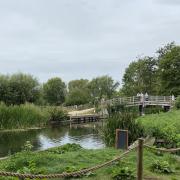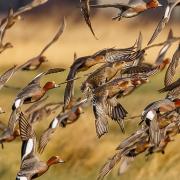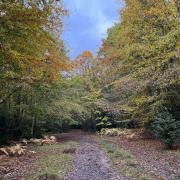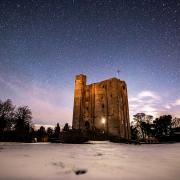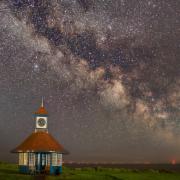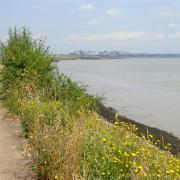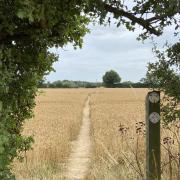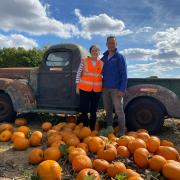One afternoon, I set out with a naturalist friend for Thameside Nature Discovery Park [frosted.shower.drum]. Despite it just turning May—the thrumming showcase of spring—this day it relentlessly bucketed down with rain. We had just walked around Two Tree Island, where we were treated to a nightingale’s song from the hawthorn, and on this high note, we pushed on up the river for Thameside, another favourite of mine.
After a warm-up and dry-off in the quiet visitor centre, we passed by the wildflower-rich garden area, usually buzzing with butterflies and bees, and, heading down the gravel path, we entered the main trail that winds through grassland. Blackbirds and robins flitted between hedges, and, entering a bird hide by the water, we found all the people. At least six others were sheltering from the weather in the bird hide, looking out onto the Thames and listening to the vigorous and penetrating notes of a song thrush.
Straight ahead, the slitted view from the bird hide opened out onto the river overlooking London Gateway, with lofty cranes picking up cargo from container ships like one of those grabby-arm arcade games. The cranes stand sentry over the industrial landscape and seem to gaze across to Kent’s rolling green hills, while ships on the river glide past silently. My eye was drawn back to a cormorant drying its wings on a navigation marker as herring gulls circled and cried overhead. Smaller pleasure boats wheeled on their painters, a sure sign that it was slack water, while a black buoy bobbed up and down, doing a fantastic impression of a seal’s head.
With the mudflats submerged, we scanned the open waters with our binoculars, spotting great crested grebes diving for fish. Small rafts of teal dabbled in the shallows along the banks. A curlew's haunting call echoed across the open expanse as it passed overhead.
Eventually the trail led us back to the visitor centre, where we enjoyed the viewpoint at the top before eventually sinking into the chairs inside. Sipping mugs of hot tea, we recounted the water birds and sights we'd encountered on our loop around this unique reserve at the edge of the estuary under the rainy, but oddly peaceful, slack water conditions. Just as we left, the sun appeared and a skylark shot into the sky, singing loudly as if it too was elated to see blue sky.

As I drove back towards Leigh station to drop off my friend, I couldn’t help but feel a sense of awe at this special place where urban grit meets rural tranquility. The cacophony of ship horns and screeching gulls melds with the gentle calls of warblers and curlews into an unexpected symphony. Here at Thameside, the line between nature and industry blurs. The reserve exists in precarious balance with the looming port and the ever-present hum of human activity. Yet these wild spaces persist, sheltering diverse life despite the encroaching development.
Even in our relentlessly modernising world, there remain pockets where we can experience a profound connection to the cycles of the natural world. Where the turning tides, calls of birds, and changing seasons can momentarily anchor us against the constant forward push.
Watching the sunlight dance off my windscreen, I felt grateful to have enjoyed this ephemeral escape into Thameside's liminal world—nestled between the human and the wild, the industrial and the emerald—and to have shared it with a friend. It is a treasure to be savoured before the march of progress inevitably alters the landscape once more.
This column uses what3words, an easy way to identify precise locations. Every three square metres on Earth has its own unique combination of three words.
To use, download the free app, or visit: what3words.com




